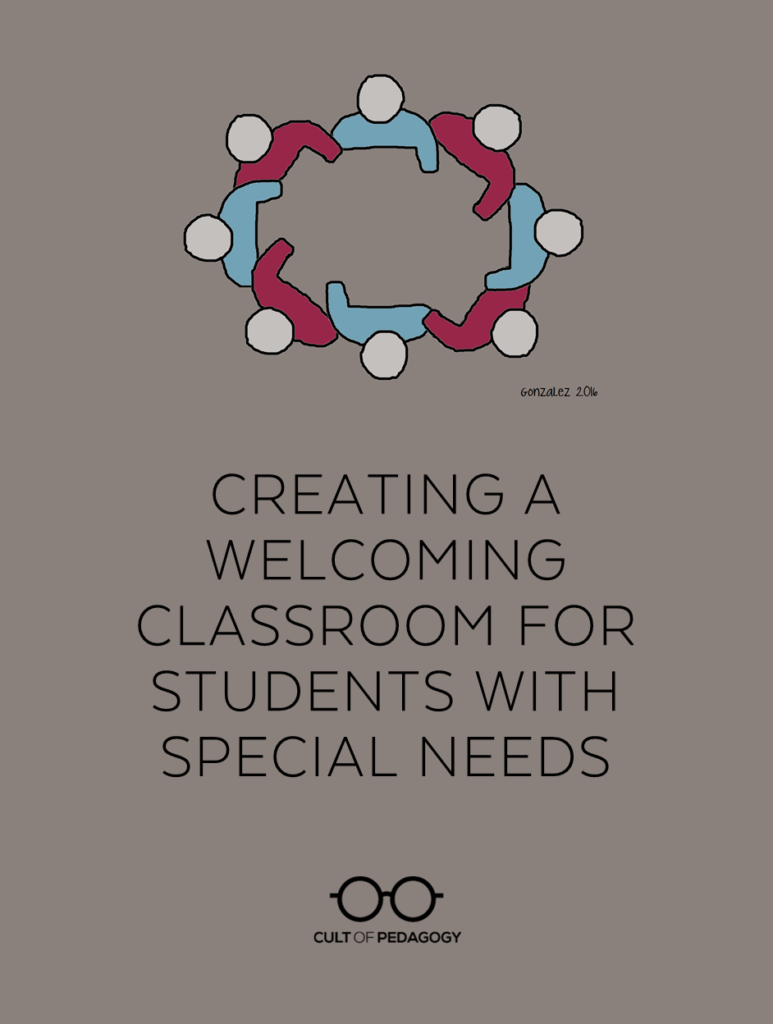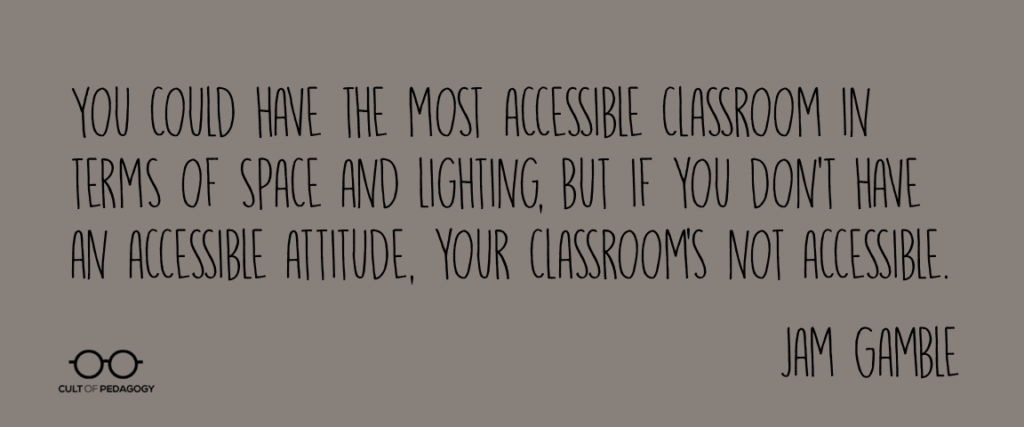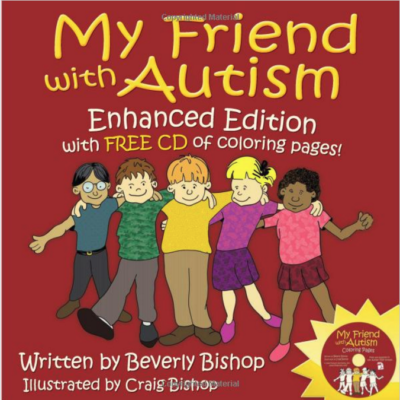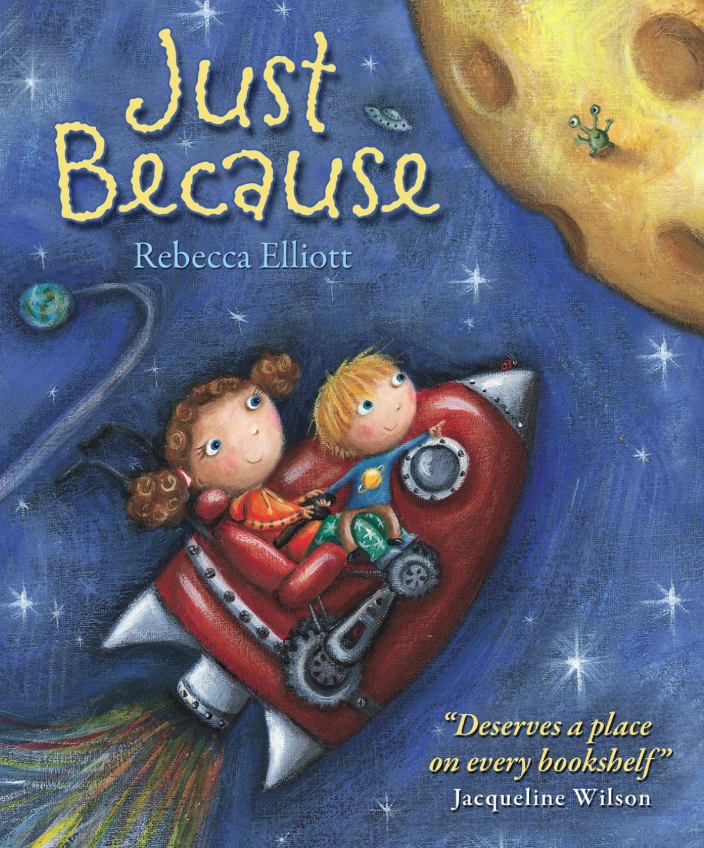Creating a Welcoming Classroom for Students with Special Needs

Listen to my interview with Jam Gamble, or read a full transcript here.
I can remember the first time I taught students with disabilities. I was teaching sixth grade, and twelve students with IEPs had been placed in a single class period with me. Despite the fact that I’d had one whole 3-credit college course devoted entirely to special education, I was absolutely clueless. I mean, I had seen the students’ IEPs, but I didn’t really know how to interpret them. I was introduced to Kathy, the resource teacher who would accompany these students to class every day, but I wasn’t sure what her role was or what shape our relationship was supposed to take.
And needless to say, that year was an absolute train wreck. I know I didn’t serve those twelve kids well, and the remaining students also suffered, because I knew nothing about how to manage a class with such a wide range of abilities and needs.
I can only imagine how different things could have been if I’d known someone like Jam Gamble. I just discovered Jam—short for Jahmeelah—on Periscope a few weeks ago. She was talking about how she dealt with a student’s misbehavior one particular day, and just listening to the love in her voice and the careful way she handled this student’s feelings told me she was the kind of teacher I wanted to know. Once I realized her work focused primarily on special ed, an area I haven’t given nearly enough attention to on this site, I knew I had to have her on the podcast.

Ms. Jam is a developmental services worker in Toronto, Ontario. She supports students with disabilities, holds workshops, consults, and hosts her own TV show called A Voice for All, which focuses on promoting disability awareness within the greater Toronto community.
When discussing possible topics for our interview, Jam and I talked about how many general ed teachers feel inadequately prepared to serve the needs of students with disabilities. Despite this lack of preparation, every year more teachers are likely to have these students in their classrooms. Because Jam spends every day doing this kind of work, we decided to have her share some ways general ed teachers could make their classrooms more welcoming for students with IEPs.
1. Express your fears and concerns.
When we think about making our classrooms more accessible, we tend to think primarily in terms of the physical space. “You could have the most accessible classroom in terms of space and lighting,” Gamble says, “but if you don’t have an accessible attitude, your classroom’s not accessible.”
She believes “inaccessible” attitudes stem from fear, from the discomfort of being assigned to work with a child with a disability and feeling ill-equipped to do so. She says the key to breaking through this is to admit your fears and talk to someone who can help. “You have to admit if you’re nervous. You have to admit if you have worries. Then you can find the right people who could help you get over those fears.”
And who are those people? “First and foremost,” Gamble says, “talk to the parents. Ask them about their child. How was their summer? How was school last year? What were goals that you wanted to see manifest last year but didn’t manifest that we could focus on this year? What are things they’re doing outside the school that we could incorporate into their lessons? Questions like that give you so much information that you can take and run with.”
The other person to confide in is the support specialist at your school. This was something I didn’t really do as a general ed classroom teacher, and now I can’t even imagine why. “This is someone who is there for the sole purpose of that student, and they understand a lot about inclusion and integration and program planning for this child,” Gamble says. “Why wouldn’t you talk to that person to get that juicy information that you need?”
2. Consult with your specialists. Regularly.
In my own experience as a classroom teacher, I rarely met with the support specialists unless I was having a problem. I didn’t meet with them proactively. That was a mistake; I didn’t fully understand what they had to offer.
Gamble says classroom teachers who make this effort, who reach out to the specialists in their building, get a lot in return. “I absolutely love some of the past teachers I’ve worked with who have come to me to like, ‘I’ll be honest with you. I don’t know where to begin. Can we talk? Tell me what your skills are.’ And I’m like, ‘Yes. Oh my goodness, yes.'”
Because special ed teachers’ resumes are not on display, classroom teachers may underestimate their skills and expertise. “Unless you ask me,” Gamble says, “you wouldn’t know I have supported people with disabilities from birth to seniors. I have a wide range of experience in terms of who I’ve supported, whether they’re lower functioning or higher functioning, someone who’s dependent or independent. I have a wide range of experience when it comes to seizures. I’ve worked with children who are nonverbal. I’ve worked with children who are verbal. I’ve worked with people who have echolalia. I’ve worked with children who have fears and phobias. I’ve worked with all these different people that I’ve taken all my personal experiences from them, and I’ve put it into this one big recipe book that a child could come in, and I could go, boom. I know exactly what to do.”

3. Design activities that challenge everyone.
Much of the time, classroom work will need to be modified for the student with an IEP. But if we occasionally flip this—creating activities that truly level the playing field—we can give that student access while also letting others experience the world the way that student does.
“Once I had a student with a visual impairment,” Gamble says, “and we created a sensory challenge where everyone had to be blindfolded, and you had to touch different objects and try to guess what they were. We did a scavenger hunt around the classroom—’Four steps to the left. Three to the right. Stop. Put your arm in front of you.’—so they could experience what it was like to move around the world with a visual impairment.”
4. Recognize that parents struggle with their own discomfort and fear.
Teachers will be more successful in partnering with parents if they’re aware that parents may need emotional support. “Some of these parents just received a diagnosis,” Gamble explains, “so they’re going through their own guilt and denial and embarrassment and shame, and all those types of emotions.”
These emotions can manifest as behaviors that teachers might misinterpret. “I’ve had parents who are very silent. They don’t want to come to the meetings. When you do get them in for a meeting, they don’t have much to say…there’s a wall that’s up. They don’t seem like they want to engage.”
When encountering parents who present with challenging attitudes or behaviors, Gamble urges teachers to withhold judgment. “You have to look at the background story before you judge these parents,” she says. “And unfortunately, I’m seeing too much judging happening. We’re looking at their external behavior, and we’re not looking at why their behavior may be happening.”
She also recommends helping parents see how vital their role is. When Gamble talks with parents, she explicitly asks them for their help. “I go, ‘I need you. I need you to meet me halfway. I want you to be invested in this, because I’m invested in your child…if you really want me to do the magic I’m capable of doing, I need you in on this with me, and if there’s things that you’re scared about, if there’s things you’re unsure about, let’s get through this together.'”
5. Read books with students that promote diversity and inclusion.
Books are a powerful tool for building an inclusive classroom culture. Teachers should seek books for their classroom libraries that have characters with disabilities. They should also read and discuss them regularly as a class.
“We don’t have to wait until Autism Awareness Month or Down Syndrome Awareness Month,” Gamble says. “This needs to be a weekly thing that we talk about being different and promoting differences and celebrating it as a uniqueness and not something that we have to be cautious about.”
Below are two of Gamble’s favorite books for sharing with younger students, along with some other highly acclaimed books for a range of age groups.
This section contains Amazon Affiliate links. If you make a purchase through these, Cult of Pedagogy receives a small commission at no extra cost to you.
Other highly-rated books that promote inclusive thinking:
Share Your Thoughts
The posts on this site get better over time because of all the insightful comments shared by readers. If you are a general ed or special ed teacher, tell us what you’ve learned about making your classrooms more inclusive. Parents, share your stories about teachers that have made your child feel welcome. ♦
Where to Find Jam Gamble
Website: www.msjam.ca
Twitter: twitter.com/Iamjamgamble
Instagram: instagram.com/iamjamgamble
Join my mailing list and get weekly tips, tools, and inspiration all geared toward making your teaching more effective and fun. You’ll also get access to my members-only library of free resources, including my e-booklet, 20 Ways to Cut Your Grading Time in Half, which has helped thousands of teachers spend less time grading!






